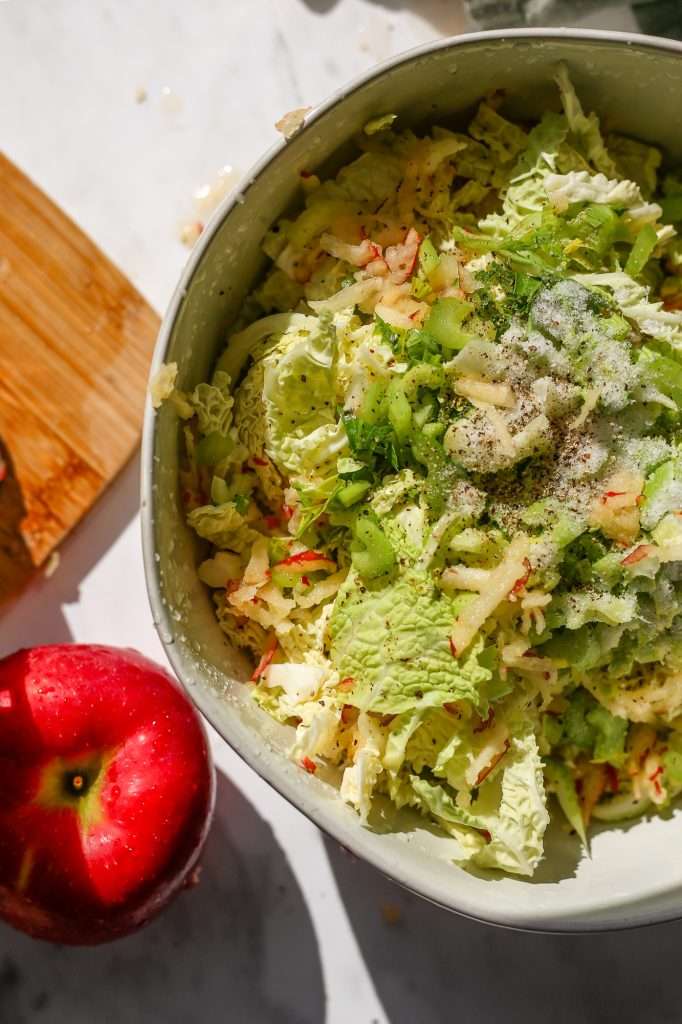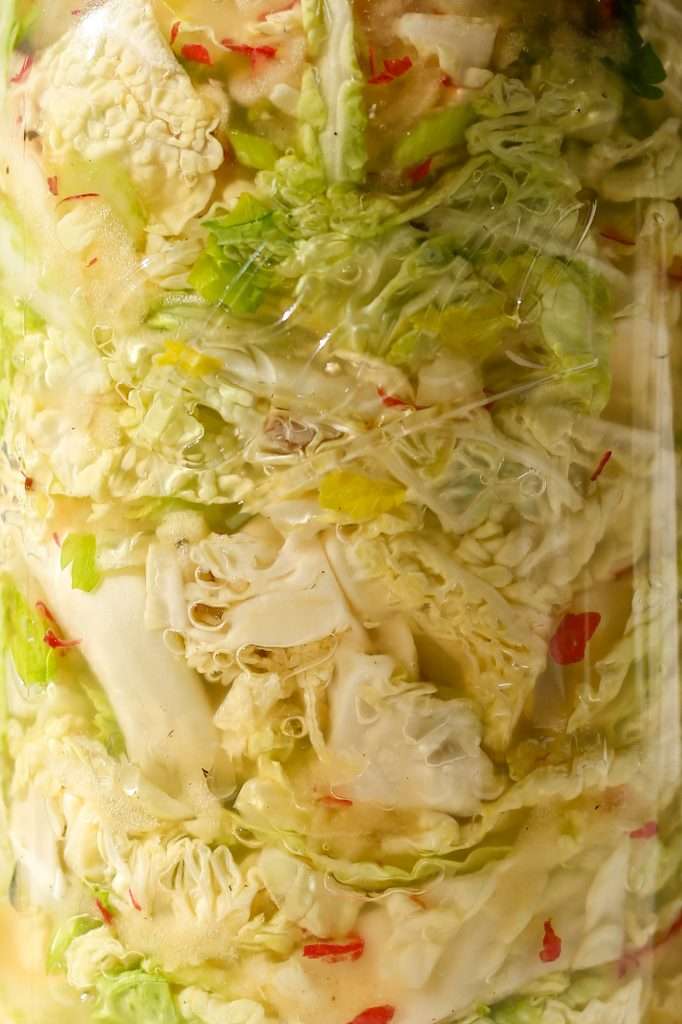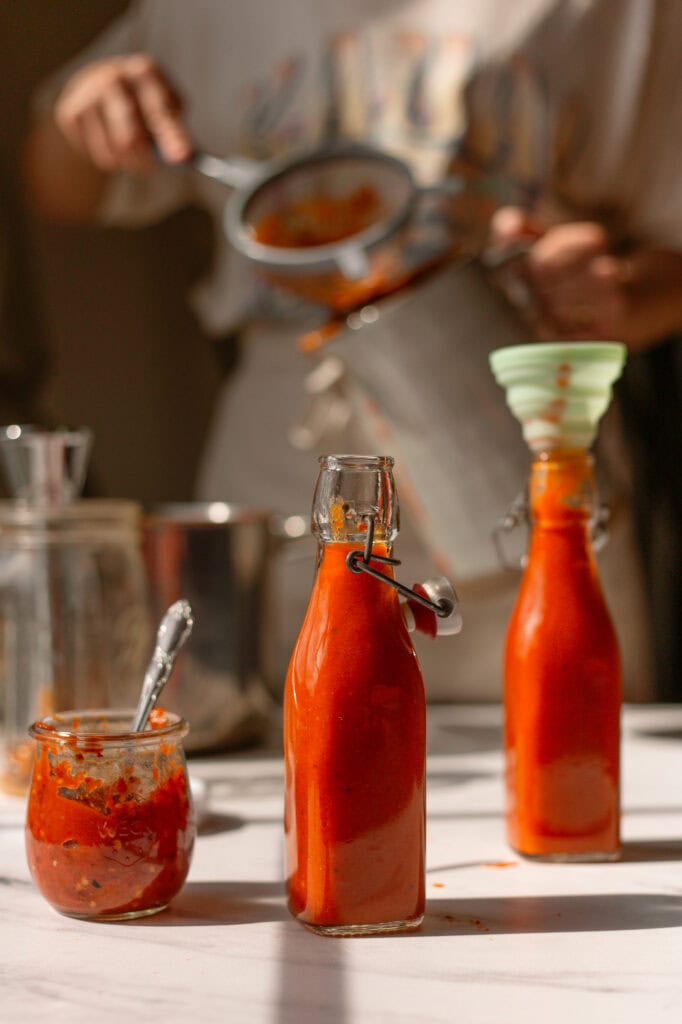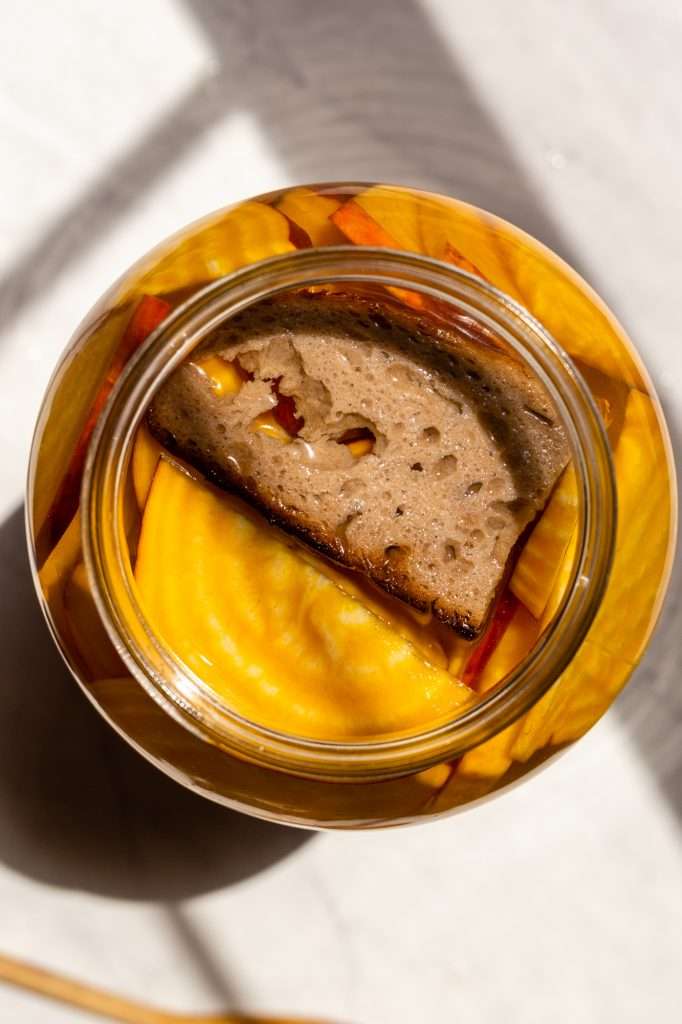Apple Sauerkraut Recipe Ingredients
Now, I never suggest trying to lacto-ferment fruit by itself. Most fruits contain too much sugar for the lacto-fermentation process and, instead, will lead to alcohol fermentation. However, when you incorporate a bit of fruit into sauerkraut, it works beautifully! So definitely try this apple sauerkraut recipe for a great way to ferment apples!
When you incorporate fruit into sauerkraut, I suggest keeping the ratio of fruit lower. Always use way more cabbage than fruit. And as always, please use organic ingredients whenever possible.

Making Sauerkraut with Apples
I love adding fruit to sauerkraut, especially apples. You know what they say…
The saying “an apple a day keeps the doctor away” is a famous adage that suggests eating an apple daily can lead to better health and thus reduce the need to visit a doctor. This phrase originated in the 19th century in Wales, and its original form was, “Eat an apple on going to bed, and you’ll keep the doctor from earning his bread.
The rationale behind the saying is based on the nutritional benefits of apples. Apples are rich in vitamins, minerals, and fiber and are a good source of antioxidants. These nutrients benefit various aspects of health, such as aiding digestion due to fiber, improving heart health, and potentially reducing the risk of certain chronic diseases.
The antioxidants found in apples can help fight free radicals in the body, potentially reducing oxidative stress and inflammation.
You know what I’m about to add here, don’t you? When fermented, the nutrients and vitamins in apples become more bioavailable!

Supplies You Need to Make Sauerkraut with Apples, Celery and Black Pepper

Fermenting Apple Sauerkraut
Sauerkraut naturally takes time. I recommend fermenting your sauerkraut for at least 14 days before eating, with 21-28 days being the best fermentation time for optimal flavor and health benefits.
By checking the progress of microbial stages under the microscope, we have provided you with a handy timeline below! If you follow our recipe and directions, your timeline of sauerkraut fermentation should approximately match ours!
Note that temperature will influence how fast or slow sauerkraut ferments. This timeline is applicable between 70-80° F. If you keep your home colder, the process is slower. If your home is warmer, it will be faster.

My Apple Sauerkraut Recipe Fermentation Timeline
24 – 48 hours: All contents in the jar should be submerged beneath the brine. At this time, there are still Gram-negative bacteria and possible pathogens present.
48 hours – 5 days: After 48 hours, you should start to see lots of bubbles being produced. This is when the ferment enters stage two of vegetable fermentation. Leuconostoc bacteria begin to thrive, and Gram-negative organisms die off.
5 – 10 days: The bubbles in the brine will decrease as the ferment leaves stage two and enters stage three. The ferment will become cloudy, the color will change, and a pleasant sour smell will develop. You should also recognize light apple and celery smells. Lactobacillus species begin to thrive at this time.
10 – 21 days: Next, Lactobacillus make up most or all of the microbial population. They produce copious amounts of lactic acid, making the fermented cabbage smell even more pleasantly sour. This is when the vegetable mixture becomes sauerkraut and is preserved.
21 – 28 days: This is when you want to smell and taste test. Wait for the kraut to smell and taste as you like, and refrigerate when you find the smell and taste most pleasant! We like ours best when we refrigerate at about 25 days.

Apple Sauerkraut Care Instructions
During the first few days of fermentation: carbon dioxide and bubbles will be produced. Sometimes mason jars will become very full of liquid, and this liquid can seep out. You will need to burp the jar.
- When burping the jar, remove the lid and tamper everything back down using a clean tamper or spoon. Make sure everything, including the weight, is still submerged below the brine. You can also rinse off the lid daily to keep things clean.
Always Trust your sense of smell: In the beginning fermenting cabbage smells funky. When fermentation is finished, fermented cabbage should smell pleasantly sour and like strong cabbage. Never eat anything that smells repulsive or yeasty.
Never eat anything that has mold growing on it: By following directions, you should not encounter this problem.
After 3-4 weeks, remove the fermentation weight, smell, and taste test. Your fermented cabbage should smell pleasantly sour. It should taste tart, salty, and cabbage. Store it in the fridge.

More Sauerkraut Recipes to Try
- How to Make Old Fashioned Sauerkraut with Caraway Seeds
- Fermented Beet and Red Cabbage Sauerkraut
- Turmeric Napa Cabbage Sauerkraut
- Homemade Kimchi Inspired Spicy Sauerkraut Recipe


Apple Sauerkraut with Celery and Black Pepper
Enjoy the unique flavors of this apple sauerkraut recipe made with celery and black pepper. This apple sauerkraut is long fermented for 21 days, giving it the best flavor and making it perfect for gut health.
- Prep: 10 minutes
- Total Time: 504 hours 10 minutes
Ingredients
- 350 grams cabbage
- 18 grams unrefined sea salt
- 200 grams filtered water
- 200 grams apple, grated
- 100 grams celery, grated
- Black pepper
Instructions
- Wash your fermentation equipment (jar, weight, and lid)
- Remove the outer leaves of your cabbage and lightly rinse the cabbage, apple and celery with cool water.
- Chop/grate the cabbage, celery and apple.
- Place your kitchen scale on the counter. Turn it on and set it to weigh in grams.
- Measure out all of your ingredients using your kitchen scale. Add black pepper to taste.
- Mix all the ingredients, including the water, in a large bowl. Lightly massage the cabbage and break up any large pieces.
- Pack it all, including the water, into a clean jar with a rust-proof lid. (a 32-ounce jar works best)
- Place a fermentation weight in the jar, making sure to submerge the cabbage pieces and weight fully into the liquid. If you don’t have quite enough liquid, place your glass fermentation weight in the jar and submerge as much as possible. Over the next 12 hours, the cabbage should release more liquid and you can press the fermentation weight down below the brine.
- Secure the lid (You do not need to tighten it all the way. Just secure the lid but leave it ever so slightly loose, so the gas doesn’t build up too much). You can keep the jar in a glass dish to catch any spills.
- Burping the jar: It should get bubbly in the first few days. If you have a tightly secured lid, you will need to burp the jar. You should also wash off the lid to keep it clean and re-adjust the fermentation weight whenever needed. Anytime the weight comes up out of the brine, with clean hands press hard on the weight to tamper everything back down into the liquid.
- Ferment at room temperature for 21-28 days, then remove the fermentation weight and refrigerate.
- If you try this recipe and love it, please leave a five-star review below!


























I’m going to try this one next. I have kimchi and hot sauce finishing up now.
What kind of cabbage is pictured here?
I appreciate the detailed description of the stages of fermentation. Having no previous exposure to fermented food, not knowing what it’s supposed to smell like or taste like, and having food-trauma in my past, knowing more about the scientific process is helping me get over the fear of making an unhealthy product.
I appreciate the detailed description of the stages of fermentation. Having no previous exposure to fermented food, not knowing what it’s supposed to smell like or taste like, and having food-trauma in my past, knowing more about the scientific process is helping me get over the fear of making an unhealthy product.
This is basically my first try at making sauerkraut. I have never even liked sauerkraut but keep trying it and am slowly starting to like it. I think I really like this though! I keep going back and trying more bites. I think next time I will add a touch more black pepper than what I did. Definitely going to try more of your recipes!
yay! I’m so glad you like this recipe! Thank you for leaving a review.
When do you add the pepper and how much?
you add it in when you add the salt, and the amount is to your taste preference
This sounds great! I happen to have some red cabbage on hand as well as celery and apples… Do you think this would work the same way with red cabbage? Thanks!
yes! it should work great with red cabbage
This recipe is just amazing!
Can you can it
I’m not sure, I’ve never tried it.
Is it normal for the apples to oxidize and brown even when submerged under the weight?
They shouldn’t oxidize, but they will change color to more muted tones, just like the cabbage.
LOVED IT!
The detailed directions made it look overly complicated but it came together so easily. So delicious. The smells as It was fermenting were gorgeous. The result is a light and crunchy peppery finish. I used my Titan peeler for the apple to get beautifully thin slices.
I have my next batch going and looking to make the kimchi inspired spicy pickles and snow peas next!
So glad you loved the recipe! Thank you for your review!
I have not made this yet as I would like to ask if I need the filtered water. If I can make enough brine from working the cabbage and apple and celery with the salt would that produce the same results ?
Thank you
The recipe is written with water as part of the total salt concentration, so you cannot just omit it. Leaving the water out will change the total salt concentration significantly the water ensures enough brine.
Bless you for putting in gram measurements, even for the small amounts! This is my next kraut: my partner loves celery and kraut – this will be a treat!
I’m wondering if caramelizing sourkraut makes it lose its nutritional qualities.
As in cooking it after fermentation? No it doesn’t loose its nutritional qualities. It’s still robustly nutritious, cooking only eliminates the live microbes, all the other benefits from fermentation are still present.
I’ve tried several recipes from this site and all with good success. I’m wondering if I should use a specific kind of apple for this recipe? And how can I wash the apples to be sure there isn’t any waxy residue on the peel? Thanks!
I wash all my apples with plain lard soap the wipe with a towel to remove any waxes.
Does it matter the kind of apple to use for the recipe?
no, you can use any kind of apple!
It says grated celery but in the photos it looks like it’s chopped in the classic crescent shapes. Did you do a mix?
I did a little bit of both. You can chop it or grate it, recipe is the same either way! 🙂
I made this 2 weeks ago. There is a white film on top of the glass weight. This is not normal, correct? Should I pitch it? I’m not sure what went wrong. (Although I didn’t wash the lid everyday, could that be it?)
White sediment on the glass weight that is still submerged below the brine is completely normal and expected. Now if there is a white film on the liquid surface, that’s different.
Are the red flecks in the photograph chopped chillies? I don’t see anything red mentioned in the list of ingredients, or in the method section. Also – I’m curious as to why you add water to the other ingredients: When I make sauerkraut, there is always plenty of liquid/brine from the salted cabbage – I’m interested in why you would dilute this.
apple is listed in the ingredients list, and the apples I used have red skins. All my sauerkraut recipes are formulated with water to account for regional and seasonal variations in cabbage water density. Basically, it ensures enough brine and cuts down on problems, especially for beginners. Nothing is “diluted” and the total salt concentration is at a perfect 2.44%.
How long does this stay good in the fridge?
at least a year!
Wow apples are such a nice touch 🌸🍎👏🏻
Can I use a bag of coleslaw mix? Would it still have naturally occurring yeasts or would that not work as well?
You can, but I suggest using in tandem with some freshly chopped cabbage. Most bagged mixes are triple washed, so they often lack the necessary microbes.
I have 2 jars going right now of the apple sauerkraut, they are on day 13. One jar has brown liquid and no longer bubbles. The other jar has clear liquid and still bubbles. Should I be concerned about the brown jar? I love your website and am going to try the kefir soon, thank You!
a little brown liquid on top is usually just oxidation. You can remove any brown bits and if it smells good and tastes right, it should still be fine to eat!
You are the easiest person to help learn fermentation. Your recipes are clearly written and precise
Sooooo delicious. Made this a few times now. Will probably be on a regular rotation of ferments.
Thank you for sharing these recipes!
I followed recipe,but used my food processor to grate the celery and apple. Think that released too much liquid because when I added all measured ingredients to the jar it filled it to the very top of the jar rim. You said it may overflow once the bubbles start so is it ok to let that happen or should I laddle out some of the liquid now? New to fermenting, but love your site.
You can just let it over flow a little! Stick the jar in a dish to catch any spills. And secure the lid, but don’t make it super tight so some gas can escape!